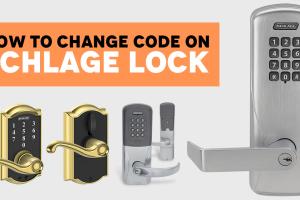Mastering Schlage Locks: A Comprehensive Guide to Changing 4-Digit User Codes

-
Quick Links:
- Introduction
- Understanding Schlage Locks
- Importance of Changing User Codes
- Preparation Before Changing Codes
- Step-by-Step Guide to Changing Codes
- Troubleshooting Common Issues
- Case Studies and Expert Insights
- Security Tips for Users
- FAQs
- Conclusion
Introduction
Schlage locks are a popular choice for homeowners looking for robust security solutions. With features that blend technology with traditional locking mechanisms, these locks offer various functionalities, including the ability to set and change user codes. This guide provides detailed insights on how to change 4-digit user codes on Schlage locks, ensuring your home remains secure.
Understanding Schlage Locks
Schlage is a well-known brand in the locking system industry, recognized for its durable and reliable products. Their keypad locks, in particular, allow users to enter a code rather than using a traditional key. This feature is not only convenient but also enhances security by allowing homeowners to change codes regularly.
Types of Schlage Locks
- Mechanical Keypad Locks: These locks use a simple keypad and mechanical components.
- Smart Locks: These are electronic locks that can connect to home automation systems and are controlled via smartphone apps.
Importance of Changing User Codes
Changing the user codes on your Schlage lock is vital for several reasons:
- Enhanced Security: Regularly updating codes prevents unauthorized access.
- Temporary Access: Easily remove access for guests or service providers without changing the entire lock.
- Peace of Mind: Knowing that only authorized individuals have access to your home increases your overall security.
Preparation Before Changing Codes
Before changing your user codes, it’s essential to prepare adequately:
- Ensure you have the current user code and the programming code, which is often found in the user manual.
- Gather any tools you may require, although most changes can be done without special tools.
- Read through the lock's manual for specific instructions related to your model.
Step-by-Step Guide to Changing Codes
Follow these steps to change the 4-digit user codes on your Schlage lock:
Step 1: Access Programming Mode
- Locate the programming code in your user manual.
- Enter the current user code.
- Press the “Schlage” button to access programming mode.
Step 2: Change the User Code
- Press the “1” button to change the first user code.
- Enter your new 4-digit code.
- Press the “Schlage” button again to confirm.
Step 3: Test the New Code
- Lock the door and then unlock it using the new code.
- Ensure the lock operates smoothly with the new code.
Troubleshooting Common Issues
If you encounter issues while changing your user codes, consider these troubleshooting tips:
- Wrong Code Error: Ensure you enter the correct current user code before attempting to change.
- Lock Not Responding: Check the batteries if using a smart lock, as low battery can affect performance.
Case Studies and Expert Insights
Numerous homeowners have shared their experiences with Schlage locks. Here are a few insights:
Case Study 1: Family Safety
A family in Texas reported that changing codes regularly helped them feel safer, especially when their children started inviting friends over.
Expert Insight
Security experts recommend changing codes every few months, particularly if you have had service personnel in your home.
Security Tips for Users
To maximize the security of your Schlage locks:
- Use unique codes that are not easily guessed.
- Keep a record of codes in a secure location.
- Consider using a smart lock that allows for temporary codes for guests.
FAQs
1. How often should I change my Schlage lock codes?
It's recommended to change your codes every 3-6 months or whenever you suspect unauthorized access.
2. Can I add multiple user codes to my Schlage lock?
Yes, most Schlage models allow for multiple user codes to be programmed.
3. What should I do if I forget my programming code?
Consult the user manual or contact Schlage customer support for assistance.
4. Are Schlage locks resistant to picking?
Schlage locks are designed with anti-picking features, making them difficult to tamper with.
5. Can I reset my Schlage lock to factory settings?
Yes, most models have a reset option, but refer to your user manual for specific instructions.
6. Do Schlage smart locks require Wi-Fi?
Smart locks typically require Wi-Fi for remote access and updates.
7. How can I tell if my Schlage lock batteries need to be replaced?
Most models will alert you with a warning light or beep when battery power is low.
8. What if my lock won’t accept the new code?
Double-check that you are in programming mode and that you are entering the correct code sequence.
9. Can I use my smartphone to change codes on Schlage locks?
Yes, if you have a smart lock, you can change codes via the associated smartphone app.
10. Is it safe to share my user code with family members?
While it is common to share codes with family, ensure they understand the importance of keeping it secure.
Conclusion
Understanding how to change the 4-digit user codes on your Schlage locks is essential for maintaining home security. By following this comprehensive guide, you can ensure your home remains safe and secure, allowing you to enjoy peace of mind.
For more information on home security systems, visit:
- Schlage Official Website
- National Crime Prevention Council
- Consumer Reports on Home Security Systems
Random Reads
- How to add slow motion to iphone video
- How to connect google chrome to chromecast on iphone
- How to create second yahoo email account
- How to download and play roblox on school chromebook
- How to find mac address
- How to find out who hacked your yahoo email
- How to scan and print pictures from a computer
- How to take apart xbox one controller
- How to turn off siri
- Easy steps add header footer powerpoint